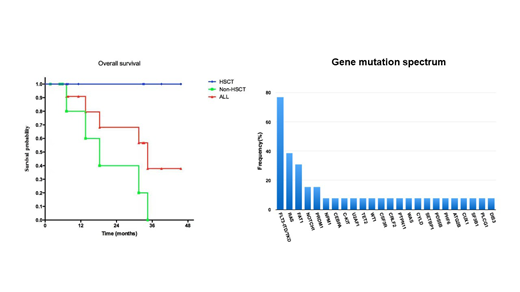Acute myeloid leukemia (AML) with t(6;9)(p22;q34) is listed as a distinct entity in the 2016 WHO Classification of Tumors of Heamatopoetic and Lymphoid Tissues, but the clinical features and prognostic impact are still not well established. We retrospectively reviewed 1620 AML patients diagnosed from the year 2013 to 2019 and 15 patients with t(6;9)(p22;q34) were identified. Their morphology, immunophenotype, cytogenetics, molecular findings, treatment and prognosis were analyzed. The incidence of AML with t(6;9)(p22;q34) is 0.9% (15/1620). There was 10 women and 5 men (ratio, 2:1) with a median age of 39 years (range:16-64). The median WBC count at diagnosis was 9.72×109/L(range: 1.78-45.4). According to French-American- British classification, 10 (66.7%) were M5 and 5 were M4. At cytogenetic level, t(6;9)(p22;q34) was the sole cytogenetic abnormality in 12 patients (80%) while 2 had one additional aberration and 1 presented with a complex karyotype. Molecular studies using next generation sequencing showed a unique mutation profile characterized by a high frequency of FLT3 mutations (10/13, 77%) including 9 cases with ITD and 1 case with TKD. Other mutations included RAS (3 NRAS and 2 KRAS) (5/13), FAT1 (4/13), NOTCH1 and PRDM1 (2/13 respectively). However, the common mutations of AML, such DNMT3A and NPM1, were rare in this subtype. The median number of mutated genes was 3 (range:1-6). Among the 9 patients with FLT3-ITD, FLT3-ITD ratio was measured in 5 patients and all showed a high ratio (median: 0.62, range: 0.59-1.11). All patients received induction chemotherapy; 12 (80%) patients achieved complete remission (CR) after one or two cycles of induction. Among these 15 patients, 7 underwent allogenic stem cell transplant (SCT) and all were alive in CR status at the last follow-up (median OS: 32.9 mon). In contrast, among the 8 patients who did not receive SCT, 5 died of disease relapse and the remaining 3 patients were newly diagnosed with a relatively short follow-up time (median OS: 10.4mon). In conclusion, t(6;9)/DEK-NUP214 AML represents a unique subtype of AML, with unique gene expression profiling (a high frequency of FLT3-ITD). Most patients can achieve CR after chemotherapy, allo-SCT can improve long term survival.
No relevant conflicts of interest to declare.
Author notes
Asterisk with author names denotes non-ASH members.


This feature is available to Subscribers Only
Sign In or Create an Account Close Modal